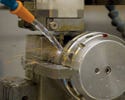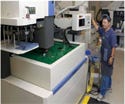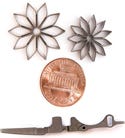Engineering and Design Options for EDM
EDM could present alternatives to conventional machining for very intricate and so-called impossible parts.
MACHINING
|
New advances make electrical discharge machining |
Electrical discharge machining (EDM) began being used several decades ago as a supplemental method for making prototypes, tools, and dies for full-production manufacturing. Today, many device engineers still see EDM as being limited to those applications. However, technological advances have made the process suitable for producing parts and components for surgical tools, implants, and other medical devices.
EDM has progressed through several evolutions and can be applied to a range of sophisticated industries—including medical.
EDM has been successfully used to create a range of medical parts, such as threads for screws used in bone-repair surgery and shaping needles used in ophthalmic and dental surgery. The process has also been applied to making miniature components used on circuit boards for pacemakers and defibrillators. Some of these components are so small that thousands of parts can fit into the palm of one hand.
EDM: The Spark of Innovation
To appreciate how and why EDM technology can shape the progress of medical device manufacturing, it is necessary to review the EDM process.
At its very basic level, EDM is similar to electrical conductive welding. That is, a power supply creates a spark between an electrode and a grounded workpiece. In the case of welding, the electrode spark fuses, or bonds, two metals to form a unified piece. In EDM, however, the electrode (typically made of brass, copper, or graphite) creates a spark that is used to melt or vaporize a metal surface layer, on a localized level and with minimal heating. The result is an extremely precise part with intricate features. For example, metal is cut away to create threads for bone screws or to channel passageways in dental needles.
More precisely, the temperature of the microspark (or electrical current) that emanates from the electrode is responsible for cutting and shaping. This spark occurs when a current path is created between the electrode and the workpiece through a water or oil dielectric fluid. Unlike other machining methods, the EDM tool itself—the electrode—does not contact the piece being machined.
Because a series of small, high-energy, controlled sparks are doing the actual work, there are no cutting-tool limitations. Therefore, many types of material can be machined, regardless of the material's hardness, gauge (thickness), shape, or contour. Using conventional machining techniques, the above parameters, and others such as gumminess, can slow or severely limit cutting results.
Materials and Advantages
|
A machinist demonstrates the sinker EDM process, which can create holes in hard-to-reach areas of a component. |
The only requirement of EDM is that the material being machined is conductive. Stainless steel, tungsten, molybdenum, tungsten carbide, hardened tool steel, and even conductive ceramic, graphite, and other high-performance or exotic alloys that are impossible or difficult to machine with conventional machining methods are suited for EDM machining.
In addition to machining extremely hard materials, EDM can also enable unobstructed access to the workpiece. Conventional machining practices require that a workpiece be secured via the use of a bulky and very rigid gripping mechanism or fixture. Once secured, access to the workpiece cutting area may be limited or severely obstructed because of the gripping fixture. EDM cuts the workpiece while it is held in place by a relatively small, light-duty fixture. Additionally, with conventional machining, the size of a feature, particularly for small precision parts, is limited by the size and strength of the cutting tool itself. This is because the part has to resist the cutting forces and not deflect or break. Such is not the case with EDM.
Of concern to medical application designers, conventional methods physically cut into the workpiece leaving behind chips, burrs, microscratches, and other rough imperfections that can compromise function and cleanliness requirements for medical procedures. A burr or rough spot could scratch or damage critical parts, such as the balloon used in stent-placement surgery, or even an internal organ or blood vessel. A burr could eventually break free and enter the body or bloodstream. To prevent such occurrences, conventionally machined pieces typically need to go through a deburring process. But deburring can also introduce other problems, such as further surface scarring.
Additional machining, of course, also adds time and cost to the process, and there remains a risk that the burred material is not completely removed by the typically operator-dependent deburring process.
The EDM electrode follows a programmed design pattern without actually coming into contact with the part. It leaves no burrs, scratches, cracks, or coarse areas on the surface of the finished product, which means that further finish machining is typically unnecessary.
EDM also offers the advantages of precision and repeatability, which are especially important to medical application designers. Cutting devices that repeatedly come into contact with the workpiece begin to wear at the initial the machining operation. This creates process variability, which is generally manifested in a degraded surface finish, decreased dimensional accuracy, or increased burring. In contrast, the EDM process can maintain tolerances within ±0.0001 in.
During the use of a wire EDM machine, for example, the electrode is fed from a spool of unused wire, ensuring repeatable accuracy regardless of the quantity of parts being produced.
As mentioned previously, the EDM spark is created in the presence of a dielectric, or semiconductive, fluid, which is typically deionized water or oil, depending on the process. This fluid serves multiple purposes. It cools the workpiece so that the spark temperature remains localized to the cutting area. This way, there are no heat-related changes to the properties of the metal being machined. In addition, the fluid flushes away the microscopic debris produced from the melted or vaporized material.
In some EDM operations, a very thin recast layer composed of resolidified material may remain on the workpiece—generally less than a few ten-thousandths of an inch or a few microns—but this can be easily removed with a simple chemical cleaning step.
EDM Methods
|
Actual parts produced by EDM processes. The upper parts are stainless-steel precursor forms of a stent. |
EDM has evolved to offer far more than its original basic application features. Today, there are various types of EDM machines, electrodes, and techniques that enable a broad range of machine-cutting options. Medical device manufacturers are most likely to use wire EDM, sinker EDM, and EDM hole-drilling machines.
Wire EDM. Considered the most production-oriented method, wire EDM uses a simple thin-wire brass electrode, available in diameters from 0.002 to 0.012 in., fed from a spool to make a single pass through the machine before being discarded. These electrodes can enter into small areas to create tiny, burr-free part features in a manner that often cannot be achieved with conventional cutting tools. The diameter of the electrode wire added to the spark gap (approximately 0.001 in.) determines the diameter of the inside corner radii and the width of the kerf (cut) produced by the cutting action. For example, a wire EDM using a 0.006-in. diam electrode can repeatedly produce an inside corner radius as tight as 0.004 in.
Sinker EDM. Also known as ram or plunge, sinker EDM uses a shaped electrode and is generally applied to more-complex shapes or profiles, particularly internal holes and recesses. It is also an effective, and sometimes the only option for producing holes or cavities with nearly any desired cross section in hard-to-reach places on a part or assembly.
|
Figure 1. (click to enlarge) This diagram illustrates the types of features that can be made using EDM. Shown here is a series of reverse draft slots made from the inside with a shaped sinker electrode |
The sinker EDM method is commonly used to machine internal or external intricate and partially hidden features such as sharp corners, reverse tapers, and internal threads (see Figure 1). A customized electrode and electrode holder machined on conventional equipment can be designed to enter a hole or cavity and is then maneuvered laterally to create the final shaped cavity. Additionally, elaborately-shaped cavities can be machined with a few simple shape electrodes to create what at first may have seemed impossible to fabricate. As the electrode wears from use and loses its defined shape, it must be either redressed or replaced.
A common practice is to use the worn electrode as a roughing electrode for the next part, thereby getting the most value out of each electrode. There are no cutting forces, so resistance or backlash from the workpiece is limited. As with all EDM processes, there are no burrs produced—only sharp, well-defined features.
One particular type of knee surgery calls for a replacement implant component with a threaded hole hidden in the bore—an area that is not accessible to a drill or tap. Because it is impossible to go through the part, the hole must be drilled from inside. In another case, a design requires that a small thread be machined inside a small barrel.
A typical drilling machine won't work because it cannot drill sideways, and it cannot be tapped. However, an EDM electrode can produce the needed holes to make these parts.
EDM Hole Drilling. EDM hole drilling has become significant only in the past decade or so. Originally, it was primarily used to produce the starting holes needed by wire EDM machines. The process involves a spinning round electrode with small holes through its center to channel dielectric fluid (DI water) to the machining interface to flush and cool the hole as it is being drilled. Although this technique is limited to producing round holes, it does this more quickly and accurately than conventional methods. And oftentimes it is more cost-effective than specialized methods such as laser cutting. It also enables the creation of holes that are closely spaced, holes with smaller diameters, deep holes, holes on angled or contoured surfaces, and holes in very hard materials.
Creating New Options for Medical Application Designers
Each machining method offers its own unique utility and purpose. However, with EDM, these methods can be combined with conventional machined features to enhance design and manufacturing functions. Certain procedures are more cost-efficient when performed on a conventional machine, but many applications benefit from the application of both EDM and conventional machining methods. For example, manufacturers often combine the processes to create different surface effects or to offset costs.
EDM has been applied to the manufacture of minimally invasive devices that may involve several small or tubular components, often with precision-designed features. These have included miniature components (some of which measure 0.040 × 0.040 in.) that go onto the circuit boards of pacemakers and defibrillators. These components are so small that their intricate features can only be seen and inspected with significant magnification.
Some medical devices might not be available today without EDM processes. One such device is a specialized needle used in dentistry. Unlike a pointed medical needle that penetrates the skin, this relatively long needle is used during an ultrasound cleaning procedure. The needles have a channel that measures 0.012 in. (equivalent to about 3 strands of human hair) through which a coolant is continuously applied to the treatment area.
Because these needles have complex shapes, an EDM hole-drilling process is used to create the holes before the needle is shaped. The part was first introduced virtually as a prototype about 10 years ago and it was very expensive. However, advances in EDM technologies and creatively engineered fixtures have enabled the part to be efficiently manufactured so that it meets the dental industry's demand.
Bridging the Design-to-Manufacture Gap
Historically, the most highly recognized medical device applications for EDM have been those for producing prototypes or small-volume production of parts. These applications primarily represent a cost-efficient and fast alternative to making very expensive die sets, which can only be amortized over high-volume production runs. EDM manufacturing methods are often applied in such cases until the market demand justifies the cost of manufacturing die sets.
|
Wire EDM machines (shown here) are suitable for high-production parts, but they can also create burr-free and very intricate features. |
Unfortunately, while this application is a benefit of EDM machining, it also contributes to a significant misconception: that EDM is too expensive or too limited to be applied to the mass-production manufacture of products such as medical devices. The previously described example of the dental needle, however, helps dispel that myth. Although expensive at first, that initial cost was justified by the necessity of the instrument. As demand for the instrument increased, EDM manufacturing costs decreased. Design and manufacturing engineers worked to find the proper application of EDM equipment and created well-designed tooling.
Misconceptions about EDM might cause designers to disregard it in the design-for-manufacture stage. By not considering EDM as a manufacturing option, a designer is in danger of limiting the overall effectiveness or applicability of the device.
More importantly, designers who disregard EDM from the outset might overlook options that are not possible by other manufacturing methods. If a designer has a required feature that cannot be machined conventionally, then EDM may be appropriate.
With creative fixturing and continued advances in engineering, it is possible to produce parts that are cost-competitive with conventional machining methods. EDM fixtures can be designed, for example, to allow multiple parts to be held and processed automatically. One recent advance provides for an automatic electrode change device for EDM hole-drilling equipment. The process eliminates the need for manual electrode replacement, thereby increasing machine throughput and capacity while decreasing operator labor.
Programmable operation, robotic control and handling, and other breakthroughs have resulted in EDM machines that operate around the clock on a three-shift, unattended basis.
Selecting the Optimal Process
So how does a design or manufacturing engineer determine whether EDM is the most effective fabrication process for the application? The simple response is that designers and engineers should compare the design's features to the relative qualities and benefits of EDM and more conventional machining processes. While the answer is generally not black and white, there are some considerations for selecting the most appropriate process. The first consideration is the actual features of the device. Design features that drive the selection away from conventional machining toward the EDM end of the spectrum include following:
Material hardness.
Burr-free sharp edges.
Small or micro details.
Accessibility to blind features.
Complex cavities.
Surface condition.
Extreme precision.
Delicate or thin sections that will not stand up to conventional machining cutter forces.
Extremely small parts that are difficult to fixture.
Small inside-corner radii.
If a design does not contain any of these features, conventional machining may be the best choice.
Determining overall cost of machining also involves a few considerations. Generally speaking, if a part can be machined either by conventional process or EDM, EDM (either by wire or sinker EDM process) will be slower and therefore cost more for fabrication than conventional machining. However, a significant advantage can be gained if the parts lend themselves to stacking or nesting in a fixture. Such parts can be nested in stacks of 10 or more to enable simultaneous fabrication. In this case, EDM may be the more cost-effective option. And it bears repeating that if the part features preclude a conventional machining solution and the features can only be accomplished through EDM, there isn't a basis for cost comparison.
This reiterates one of the main messages of this article, specifically that EDM processing opens design features that have historically been impossible. By assessing EDM's technological advances, design engineers may see new opportunities for precision parts.
Pat Lorenz is general manager of Veridiam Advanced EDM (San Diego) and can be contacted at [email protected]. Norm Turoff is director of technology at Veridiam Advanced EDM and can be contacted at [email protected].
Copyright ©2007 Medical Device & Diagnostic Industry
About the Author(s)
You May Also Like







